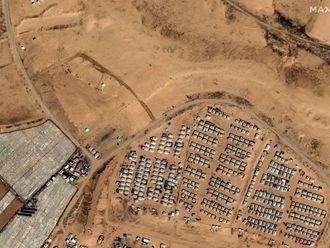GAZA CITY: Their faces covered with black balaclavas, AK-47s in hand, militants from Hamas’s armed wing have become a familiar presence in the Gaza Strip — and for many that remains a key problem.
Hamas has been seeking to end its long feud with Palestinian President Mahmoud Abbas’s Fatah, but its powerful armed wing may prove to be a dealbreaker.
The Palestinian National Authority is due to take control of Gaza by Friday under a reconciliation agreement signed in October, but Hamas is flatly refusing to disarm.
Security control could derail the long-awaited accord, with Abbas warning he will not accept a situation akin to Hezbollah in Lebanon, where the group’s militia wields major power.
“The weapons of the resistance are a red line that is non-debatable,” Khalil Al Hayya, deputy head of Hamas in Gaza, said at a press conference on Monday.
“These weapons will be moved to the West Bank to fight the [Israeli] occupation. It is our right to resist the occupation until it ends.”
The size and strength of Hamas’s armed wing, the Ezzedine Al Qassam Brigades, has been a source of speculation.
Hamas, which seized control of Gaza in 2007 in a near civil war with Fatah, does not comment on such details.
Al Qassam membership has been estimated at 20,000-25,000 — roughly the size of the Czech Republic’s active military personnel, according to figures cited by the World Bank.
Before a devastating 2014 war with Israel, armed groups in Gaza were believed to have a total of some 10,000 rockets, including 6,000 for Hamas, an Israeli military analysis at the time said.
Hamas’s weapons are key to its ideology, with officials from the group saying they are needed for defence against Israel.
“When Israel occupied Palestine, Israel did not come with flowers, with roses,” said Gaza-based academic Asad Abu Shark.
“We have to have arms in order to defend.”
In October the Israeli occupation forces blew up a tunnel stretching from Gaza, resulting in the deaths of 12 Palestinian fighters.
But Hamas’s armed resistance has recently run up against other pressures in the Palestinian enclave of some two million people.
Under an Israeli blockade for more than a decade and with its border with Egypt kept largely closed in recent years, Gaza has seen worsening humanitarian conditions.
Hamas has sought help from Cairo — hoping to have the Rafah border with Egypt opened — and has faced pressure to pursue reconciliation in return.
A deal mediated by Egypt was signed on October 12, though it lacks details on security control.
A first deadline was met, with Hamas handing over Gaza’s borders to the Palestinian National Authority on November 1.
The next, more important deadline comes on December 1, when Hamas is supposed to give up its decade-long dominance of Gaza and hand power to the PNA.
But there are doubts over what kind of transfer will occur and whether it will be mainly symbolic.
Gassan Khatib, a former PNA minister, said basic differences between Fatah and Hamas on how to pursue the Palestinian cause — diplomatically or through armed resistance — would prevent reconciliation unless overcome.
“So long as we have these differences, the division will remain,” he said.












